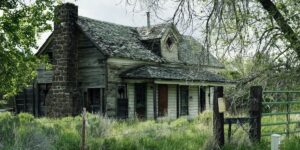7 Pitfalls to Avoid When Buying an Historic Home

No one can deny that historic homes are gorgeous, but you should always be cautious before purchasing one.
For every pro a historic house offers, there’s a hidden con to counteract it. The good news is you can avoid being sucked into a money vacuum purchase by becoming aware of the cons before you purchase the home.
Here are some of the pitfalls of a historic home you should always keep in mind and look for:
Strict Rules
Homes in designated historic districts come with strict rules.
Many times, historic homes are in disarray before they are purchased. You may be thinking of adding a new exterior paint job, putting in a porch, or even building on to renovate the home.
Unfortunately, all of these additions usually require city permission and many are not approved. Some places even require you to pick from specific historic paint palettes if you’re considering painting to keep the historic integrity of the home intact.
Before you purchase a home, if you think you may want to alter the exterior at all, contact your city development office for specific details on their regulations.
Hidden Extras
Old homes have had years to collect dust…and other things.
You should always have older homes carefully inspected, especially for things you might not think of when purchasing a newer home.
Many older homes are hiding termites, mold, or asbestos. All of these are fixable, but some do require a pricey removal so be sure you can make the investment before tying yourself to the home.
Structural Issues
Historic homes have been standing for what seems like forever, but 100 years of wear can cause lots of structural issues.
Hire a structural engineer to check for foundation issues which can range from small settlement cracks to damaged support footings. These issues stem from a range of things such as constantly wet soil, seismic activity, or even large tree roots.
If you are touring a house, always look out for wall cracks, doors that won’t latch, uneven floors, and jammed windows as signs for possible foundation issues.
Damaged Roof
Having a home means having a roof over your head. Unfortunately, many older homes’ roofs are in dismal shape.
Check for missing roof shingles, bowing gutters, and leaks in the attic for signs of an impending roof replacement.
Although the problem is easily fixed, a new roof can be a pricey investment.
Hazardous Materials
Many older homes used hazardous building materials.
Any home built pre-1970 likely used asbestos, lead paint, and lead or polybutylene pipes. And, depending on how recently the home was renovated, these issues may still be present.
Lead paint is toxic to humans and can cause life-threatening health issues. It also requires professional removal. Asbestos is likely hiding in the wall insulation and is a known carcinogen. It is recommended it be professionally removed as well.
As for lead pipes, as they get older they decompose and can cause lead to end up in your water supply. Polybutylene pipes, on the other hand, are susceptible to corrosion by bleach and modern cleaning chemicals which leads to the pipes bursting.
Always have an inspector check the home for the materials above before purchasing since each requires pricey removal and replacement.
Outdated Wiring
Electricity is a modern miracle and, as such, has evolved immensely in the past 100 years.
The older a home is, the more likely it is to have outdated electrical wiring. Any wiring installed before 1960 is thought to be able to last 70 years, meaning in the next ten years, you’ll likely need to replace all of your electrical wiring.
Additionally, any ungrounded outlets (2-prong) need to be changed to ground wiring. And, if the home has knob and tube wiring, it could hinder your ability to get homeowners insurance or even a mortgage.
When purchasing an old home, be sure to have an electrician inspect all of the wiring.
Older Appliances
Technology is another modern amenity that many older homes are not equipped for.
Many historic homes have out-of-date machinery including water heaters, furnaces, air conditioning, and more.
Each of those appliances have a lifetime anywhere from 10 to 30 years, so chances are they will need to be replaced soon. Additionally, make sure any other equipment you are moving into the home fits, including refrigerators, stoves, and washer and dryers.
A lot of equipment decades ago was not as large as it is now, so make sure the house can accommodate those pieces.
Conclusion
Historic homes are lovely and come with many pros.
They are often located in beautiful neighborhoods and guarantee a return on your investment. Just make sure that before you buy the home, you can truly invest in everything you may need to make it livable.
Although many of the possible pitfalls of a historic home are fixable, they are costly. Always do your research and have professionals inspect the home for any possible hidden expenses.
Historic Restoration & Home Remodeling in Maryland
James R. Irvine Construction has specialized in residential home remodeling and historic repair since 1985. We know buying a historic home is a huge undertaking, which is why we are here to help you along your home’s restoration and repair journey. Contact us today for a consultation!